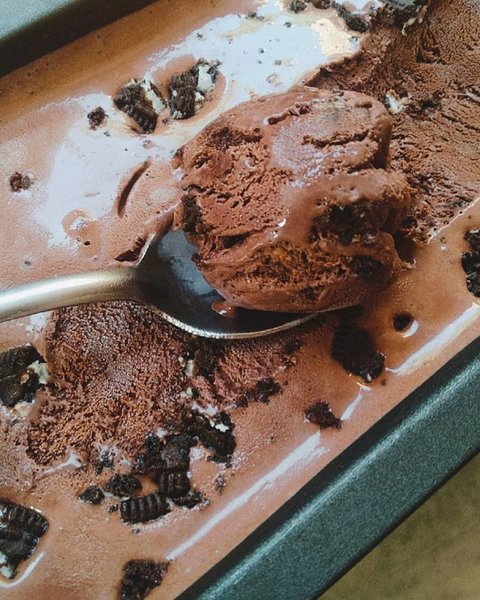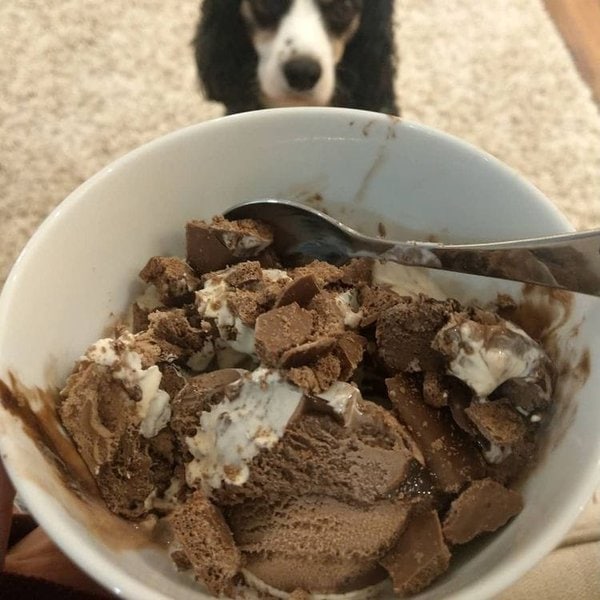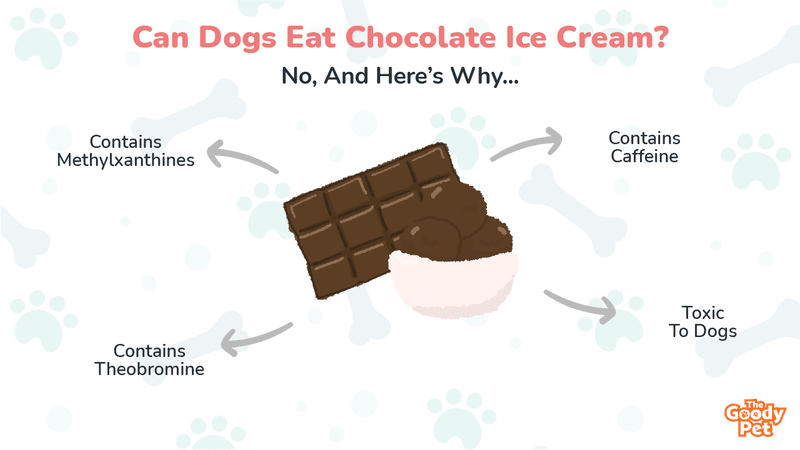The hot weather just led you to the fridge. And what other treats would work better for such a time than chocolate ice cream? So yes, you pick one and get back to watching. And as soon as you taste it, all your Fido’s eyes turn to you. The urge to share the treat becomes almost irresistible. But can dogs eat chocolate ice cream?
No, dogs can’t eat chocolate ice cream. Chocolate ice cream has methylxanthines which affect dogs’ central nervous system when ingested. As such, always keep this treat as far as possible from your furry friend.
Today, we will be telling you why chocolate ice cream doesn’t make a healthy treat for canines. What makes it bad? What happens when dogs eat this treat? How much chocolate ice cream does it take to hurt or kill a dog? When is a vet visit necessary?
That’s not all. I mean, there’s so much in here that you should know! Let’s dive right into it!
Is Chocolate Ice Cream Bad For Dogs?

Yes, chocolate ice cream is bad for dogs. Unlike humans, dogs can’t break down the methylxanthines in chocolate. For that reason, chocolate ice cream will cause chocolate poisoning for dogs, a lethal occurrence.
Dogs share lots of similarities with humans. For instance, they are all mammals, need constant affection, and of course, they are both social beings. However, that doesn’t mean humans and canines have everything in common.
We have a few things we do that dogs don’t. For instance, we pay taxes. Dogs don’t. And even more relevant to the topic, our bodies can metabolize chocolate compounds, unlike those of our furry friends.
As such, it’s generally not a wise idea to share anything containing chocolate with dogs. Sure, much like humans, pups enjoy the taste of this treat. However, chocolate ice cream to dogs can attract a plethora of health complications.
Most of us love chocolate-flavored ice cream, and it offers lots of health benefits to us, but that doesn’t qualify it as a healthy treat for canines. So yes, to keep your canine happy and healthy, never think of giving dogs chocolate ice cream.
If you have to enjoy chocolate, have it when you don’t have your dog with you. Still, you can get a healthy treat to keep your fur baby just as happy as you enjoy your favorite summer treat. Thankfully, we have tons of snacks that work best for canines in the summer heat.
Why Is Chocolate Ice Cream Bad For Dogs?
Chocolate ice cream is bad for dogs because it can easily land them in emergency rooms. As sweet and tasty as this treat is to humans, chocolate ice cream can cause deadly effects in dogs.
Methylxanthines compounds are the major threats here, and that includes theobromine and caffeine. The effects of the two compounds in dogs are much the same, although theobromine is deadlier than caffeine.
Unfortunately, all forms of chocolate contain at least one of these two compounds. What that means is that a “safe” chocolate-flavored treat for dogs doesn’t exist. Even worse, of the two substances, theobromine comes in higher concentrations in most chocolate ice creams, so the likelihood of dogs developing health issues from ice cream is more pronounced.
Usually, the darker the chocolate, the more theobromine it contains, and the more poisonous it is to dogs. That means the dry cocoa powder is the most toxic form of chocolate, while white chocolate comes last on the same list.
However, all the danger in chocolate ice cream doesn’t come from methylxanthines. This treat also packs tons of sugar. To be more precise, there’s an ounce of sugar for every cup of chocolate ice cream. So yes, other than poisoning, this tasty treat can also attract cavities, obesity, and other conditions.
Some dog parents argue that a small amount of chocolate ice cream won’t do dogs any harm. That could be true. But let’s be honest here – we have lots of healthy treats for dogs to choose from, so you shouldn’t risk feeding your dog chocolate ice cream.
But how small is this “small” amount that dogs can eat? What quantity of chocolate ice cream can cause issues for dogs? Well, we still have that section coming later on in this article. But first, let’s look at the potential aftermaths of your dog feasting on chocolate ice cream.
What Happens If My Dog Eats Chocolate Ice Cream?

If a dog eats chocolate ice cream, what happens is that it will experience gastrointestinal issues, neurological problems, and heart-related conditions. Your dog will more likely develop stomach upset, diarrhea, tremors and seizures, abnormal heart rate, rapid breathing, and restlessness.
Those are just a few of the effects of pups eating chocolate ice cream. They range anywhere from mild to severe, but death is also a possibility. The severity of the conditions mostly depends on the intake level, the dog’s body weight, and the health status of the dog involved.
On the intake level, toxicity increases with an increase in the consumption of something harmful. By eating plenty of chocolate ice cream, dogs end up with more toxic compounds, making more serious consequences very likely.
About the body weight, dogs weighing less are more prone to toxicity. That means if you have a small dog, let’s say a Yorkie, then you need to offer an extra bit of tender love and care to keep them from toxic substances like chocolate ice cream.
Regarding the dog’s health status, chocolate ice cream will exacerbate some existing conditions in dogs. For instance, you have a pup suffering from diabetes, heart disease, kidney problems, or other conditions, avoid giving them even a small amount of this treat.
Should I Make My Dog Vomit After Eating Chocolate Ice Cream?
Yes, make your dog vomit after they eat chocolate ice cream. In fact, inducing vomiting needs to come as soon as possible after your dog eats the chocolate-flavored treat. If you aren’t sure of the eating but have a few things that imply possible ingestion, try and make them vomit.
However, before you trigger vomiting in dogs, contact the vet first. They will confirm whether making your dog vomit is the ideal step to take. The dog expert may also suggest the inducer to use and in what doses.
One way to induce vomiting in dogs is by using 3% hydrogen peroxide. This solution is safe for dogs. A teaspoon for every 5 lbs of the dog’s weight should be enough to make them throw up. Only don’t exceed three tablespoons for pups weighing over 45 lbs.
One thing to do before you offer hydrogen peroxide – feed the dog a small amount of food. Moist foods work better in this case. That tiny amount of substance will a great deal make inducing vomiting easy.
Hydrogen peroxide takes about 15 minutes to make a dog throw up. At times the wait is longer. The first round can even turn out unsuccessful. That’s still normal. When that happens, repeat the process. Only keep it a teaspoon for every 10 lbs of body weight the second time.
Using hydrogen peroxide doesn’t come without a caveat, though. There are a few exemptions to using this inducer. For instance, avoid using this solution for dogs exhibiting the following signs;
- Lethargy
- Difficulty in breathing
- Seizures
- Hyperactivity
Dogs with recent abdominal surgery are another category that shouldn’t take hydrogen peroxide. This inducer could make things worse. That’s another reason to get in touch with the vet before you offer any form of remedy.
How Much Chocolate Ice Cream Is Toxic For A Dog?
How much chocolate ice cream is toxic to dogs depends on the chocolate content of the ice cream. It will take 0.5 oz of milk chocolate per pound of body weight and 0.13 oz of dark chocolate (or semi-sweet variety) per pound for poisoning to happen in dogs.
So yes, before you make a journey to the vet, find out what amount of chocolate is in the ice cream your dog ate. You can find this information on the ice cream container. Where possible, carry the can together with the remaining amount of chocolate (if any) to the pet clinic. The dog doctor will use it to know the toxicity level and the appropriate treatment measures to take.
After eating, dogs will exhibit these signs of poisoning;
- Increased urination
- Tremors
- Rapid heart rate
- Restlessness
- Hyperactivity
- Gas
- Vomiting
- Diarrhea
- Death

How Soon Will A Dog Get Sick After Eating Chocolate Ice Cream?
How soon it takes a dog to get sick after eating chocolate ice cream typically ranges between 6 to 12 hours.
However, this period can vary subject to the overall health status of the dog and the level of toxicity. High toxicity cases and dogs with underlying medical conditions take a shorter time than 6 hours.
“Sugarless” ice creams can contain xylitol, a more dangerous dog poison than chocolate. Where ingestion of such a treat happens, it will take a much shorter time for sickness to develop. It could be as soon as minutes after ingestion.
So yes, have your dog get treatment as soon as possible. After treatment, it will take about 72 hours before the signs resolve. Again, this time varies depending on the overall health of the dog and the toxicity level. Large poison intakes and pups with pre-existing conditions will again need more time to recuperate.
More often, poisoning from chocolate ice cream isn’t lethal. It can still happen, but that will need massive ingestions of methylxanthines, an amount just too large to find in chocolate ice cream alone.
How Much Chocolate Ice Cream Will Kill A Dog?
How much chocolate ice cream will kill a dog largely depends on the amount of theobromine content in it. It can take as little as 20 mg of theobromine to cause death in dogs. Signs and symptoms take smaller theobromine doses of 9 mg to manifest.
Dark chocolate has the highest concentration of theobromine, containing between 130 to 450 mg of this dog poison per ounce. So yes, sometimes it may take less amount than anyone would think for dogs to die of eating chocolate ice cream.
White chocolate has 0.25 mg of theobromine per ounce, so it’s the least dangerous of all chocolate varieties. But again, it still contains other deadly ingredients, so it’s also a no-no for dogs.
For instance, white chocolate is high in fats. As such, it can cause pancreatitis and a long list of other illnesses in dogs. In addition, this chocolate contains a lot of sugar, making obesity, diabetes, and other sugar-related conditions a possibility from eating this variety.
When Should I See A Vet After My Dog Eats Chocolate Ice Cream?
You should see a vet as soon as you learn that your dog ate chocolate ice cream. You see, different dogs respond differently to poisoning, so you can’t afford to sit back and assume that things will go well with your pup.
Chocolate ice cream can cause poisoning in dogs, so it needs the weight and urgency you would treat any other poison. Immediately contacting the vet will help avoid a lot of trouble for you and your dog.
But before you contact or visit the vet, there are a few things to do at your end. First, you have to find out the chocolate content in the ice cream your dog ate. You will find this information on the ice cream container.
The doctor may also need to know when ingestion happened and the amount of chocolate ice cream the dog ate. You can carry the chocolate ice cream container together with the remaining amount of chocolate if at all there’s any.
The vet will perform several tests to assess the seriousness of the matter. The results of the assessment and the information you provide will help them know the toxicity level. From there, the vet can adopt the most appropriate treatment measures.
Vomiting is most of the time what vets use as a way of getting rid of harmful substances. The dog professional could also wash the stomach and offer activated charcoal to help absorb the remaining amount of theobromine in the intestines.

How Do You Treat Chocolate Poisoning In Dogs At Home?
Treating chocolate poisoning in dogs most of the time involves trying to make the dog vomit. And as said, you shouldn’t take this step unless you have confirmation from the vet that it’s the right thing to do.
Contacting a dog professional will also help you find information on the different ways of inducing vomiting after a dog eats chocolate ice cream. Some of the likely recommendations include the use of dilute hydrogen peroxide, saltwater, ipecac, or other options.
If you aren’t in a position to reach the vet, calling an animal poison control center is necessary. Either ASPCA Poison Control or Pet Poison Helpline should help. However, expect to pay a small amount of fee. And who cares about how much they spend to save the life of their adorable furry friend?





